When it comes to the time you spend at the gym, there are enough things to make you feel anxious without having to worry about sexual harassment.
Harassment can happen anywhere and anytime – and the gym isn’t off limits. This harassment may occur physically or verbally, or as one woman found out, even escalate to another gym-goer taking pictures without someone’s consent. How comfortable can you truly feel exercising if harassment is taking place all around you and going unresolved?
To learn more, we polled 1,000 Americans about their experiences with sexual harassment at the gym, including what qualifies as harassment (such as being hit on or stared at) and the changes they made in their routine to avoid similar situations. Curious how many people aren’t working out at all just to avoid these uncomfortable experiences? Read on to learn more.
Negative Gym Experiences
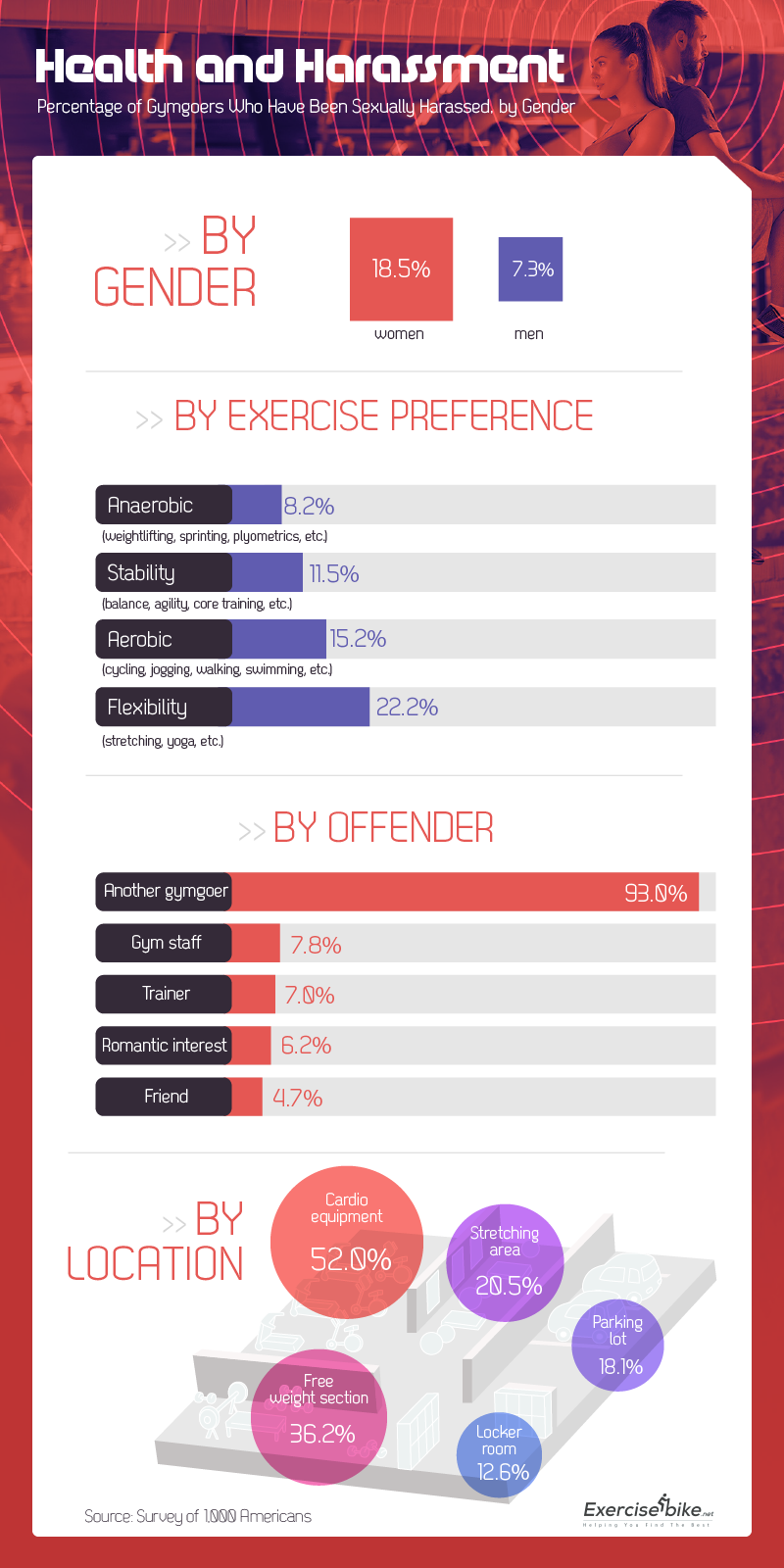
We asked men and women to share their experiences with sexual harassment at the gym. Based on their responses, we learned sexual harassment – from physical contact to verbal violations – was far more likely to occur to women than to men. While more than seven percent of men cited harassment while working out, over twice as many women – nearly 19 percent – said the same.
A fellow gymgoer perpetrated a vast majority (93 percent) of these harassment incidents compared to less than 8 percent by staff and 7 percent by a trainer.
Certain exercises and equipment might also be at a higher risk for these unwanted advances. More than 22 percent of people who were harassed preferred flexibility workouts (including stretching and yoga) and over 15 percent participated in aerobic exercises (including cycling and jogging).
Americans also indicated the most common place for these inappropriate confrontations: cardio equipment. More than half of respondents were harassed while using cardio machines including the treadmill, elliptical, and stationary bikes. More than 1 in 3 had similar encounters around free weight stations, while over 18 percent said their aggressor followed them to the parking lot.
Defining Sexual Harassment
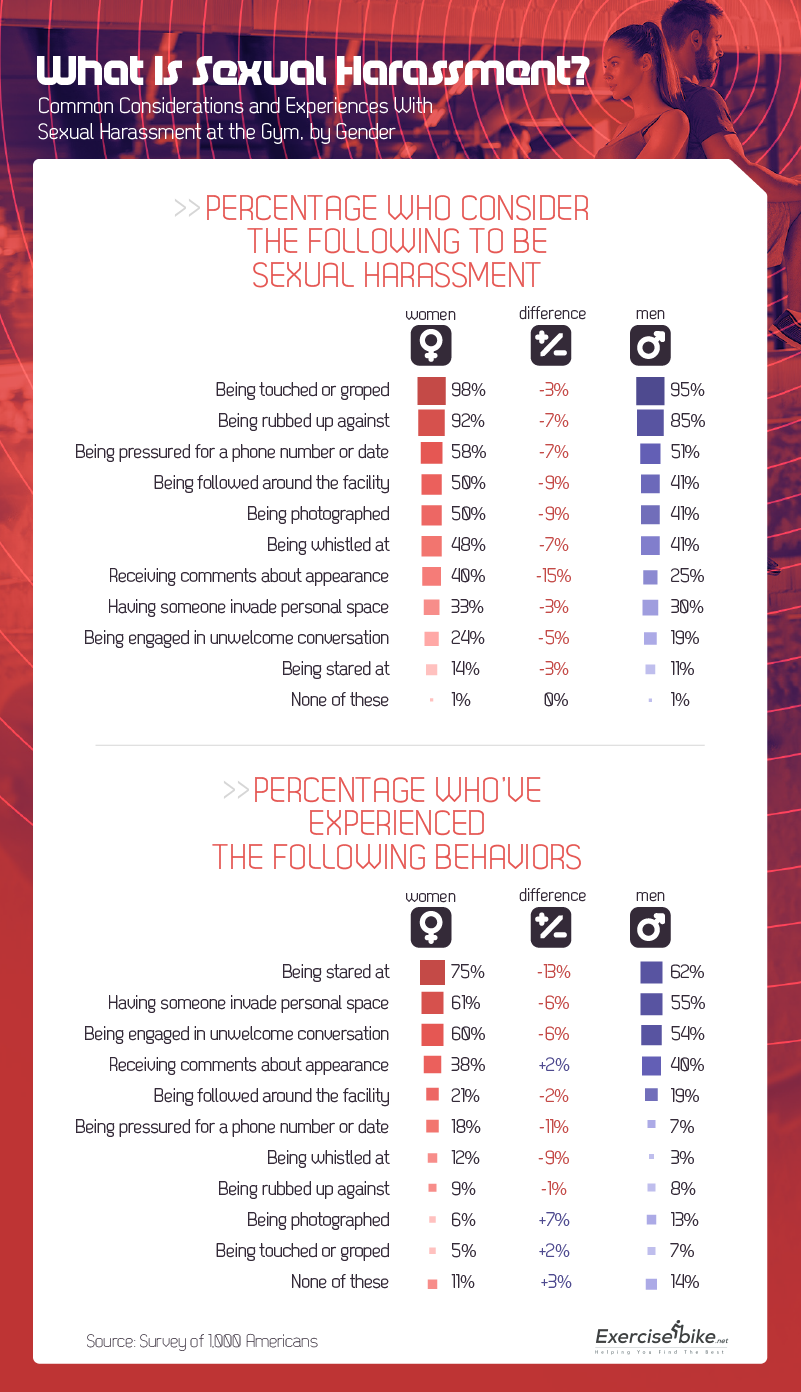
At a time when sexual harassment is being exposed in Hollywood, academia, politics, and the American workforce, it may be more important than ever to define what constitutes sexual harassment in the eyes of men and women around the country.
When asked about gym behaviors that crossed the line, 98 percent of women and 95 percent of men agreed being touched or groped without consent qualified as harassment. Ninety-two percent of women and 85 percent of men said being rubbed up against carried the same connotation. And while popular opinion on this topic may vary, over half of men and women said being pressured for a phone number or date wasn’t just annoying – it was harassment.
However, women were more likely to be uncomfortable with someone following them around the facility or photographing them, and while only 25 percent of men said receiving comments about their appearance qualified as harassment, 40 percent of women said it was over the line.
Despite only 14 percent of women and 11 percent of men suggesting that being stared at while exercising classified as harassment, 3 in 4 women and over 3 in 5 men experienced being watched while working out. Men were more likely to receive comments about their appearance or to be photographed (which a majority said they didn’t mind), while women experienced invasions of personal space and unwelcome conversation more frequently.
Switching Gears
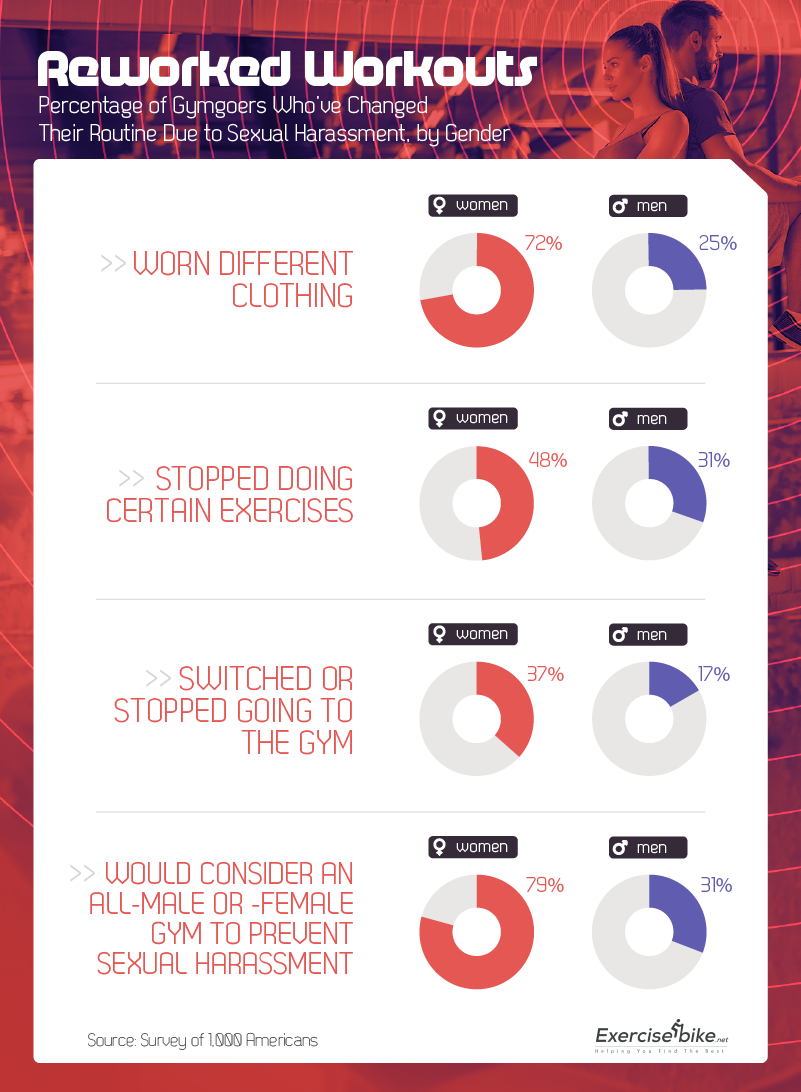
People who experience sexual harassment may walk away from their experience with different emotional responses, but experts suggest the three most common responses are depression, anxiety, and post-traumatic stress disorder. Given the serious trauma these encounters can create, we asked people who experienced harassment at the gym how they changed their workout routine following the incident.
Women had a stronger reaction to sexual harassment than men. Nearly 3 in 4 women said they changed what they wore, almost half said they stopped doing certain exercises, and more than 1 in 3 either changed gyms or stopped going entirely. While only 31 percent of men said they considered going to an all-male gym to help avoid harassment, 79 percent of women said they considered transferring to an all-female gym to avoid these uncomfortable interactions.
Changing your choice of clothing might not seem like a big deal, yet clothes have the power to help reflect not only people’s personalities but also their self-image. Being forced to relinquish the choice of attire to avoid unwanted attention could be important for some.
Forecasting Reactions
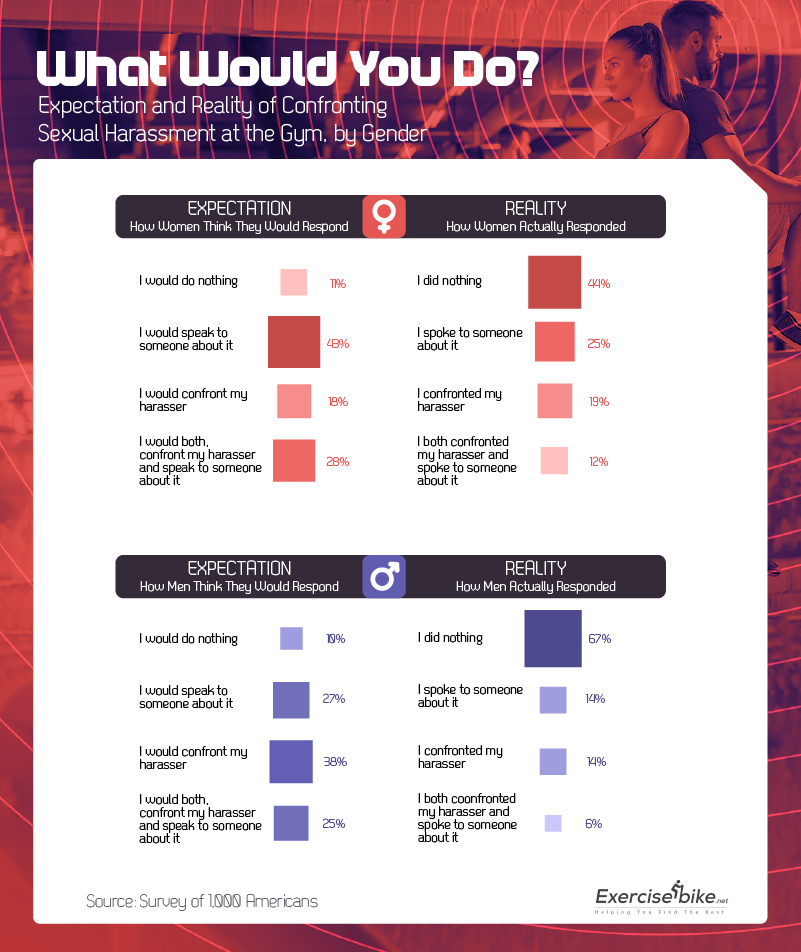
One of the most common responses that plagues victims of sexual harassment calls into question why they often wait to call out their offenders. In reality, it’s not uncommon for men and women to experience feelings of shame at harassment directed toward them or to fear the retaliation they might incur as a result of speaking out.
While only 11 percent of women didn’t think they would react to being sexually harassed at the gym, 44 percent of women actually did nothing when confronted with harassment. Another 43 percent said they thought they would talk to someone about the incident, but only 25 percent actually did. In contrast, 18 percent said they thought they might confront their harasser, and 19 percent followed through.
Our survey revealed men were even less likely to respond or speak out if faced with sexual harassment at the gym. Only 1 in 10 said they thought they might not take action if harassed, and over 1 in 3 said they expected to confront their harasser. As we found, only 14 percent actually felt comfortable confronting the person who sexually harassed them, and over 2 in 3 men did nothing about the assault.
Adverse Actions
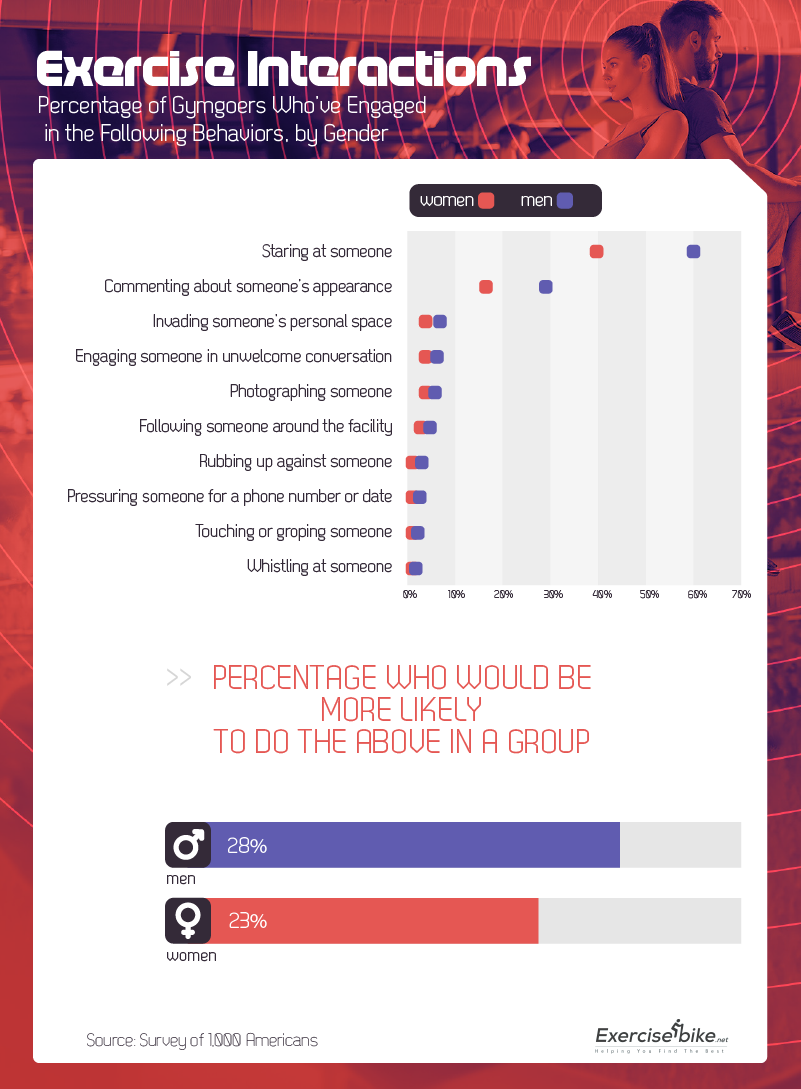
Despite the impact sexual harassment can have on the people who experience it, how likely is it that you’ve done something that may have been considered harassment by someone else?
Roughly 3 in 5 men admitted to staring at someone while working out, and more than 1 in 4 commented on someone’s appearance at the gym. Men were also more likely to invade another person’s personal space, engage in unwelcome conversation, and even to photograph someone without his or her consent.
Our study also revealed 28 percent of men acknowledged they were more likely to participate in what could be considered sexual harassment when they were in a group compared to 23 percent of women.
In Their Own Words
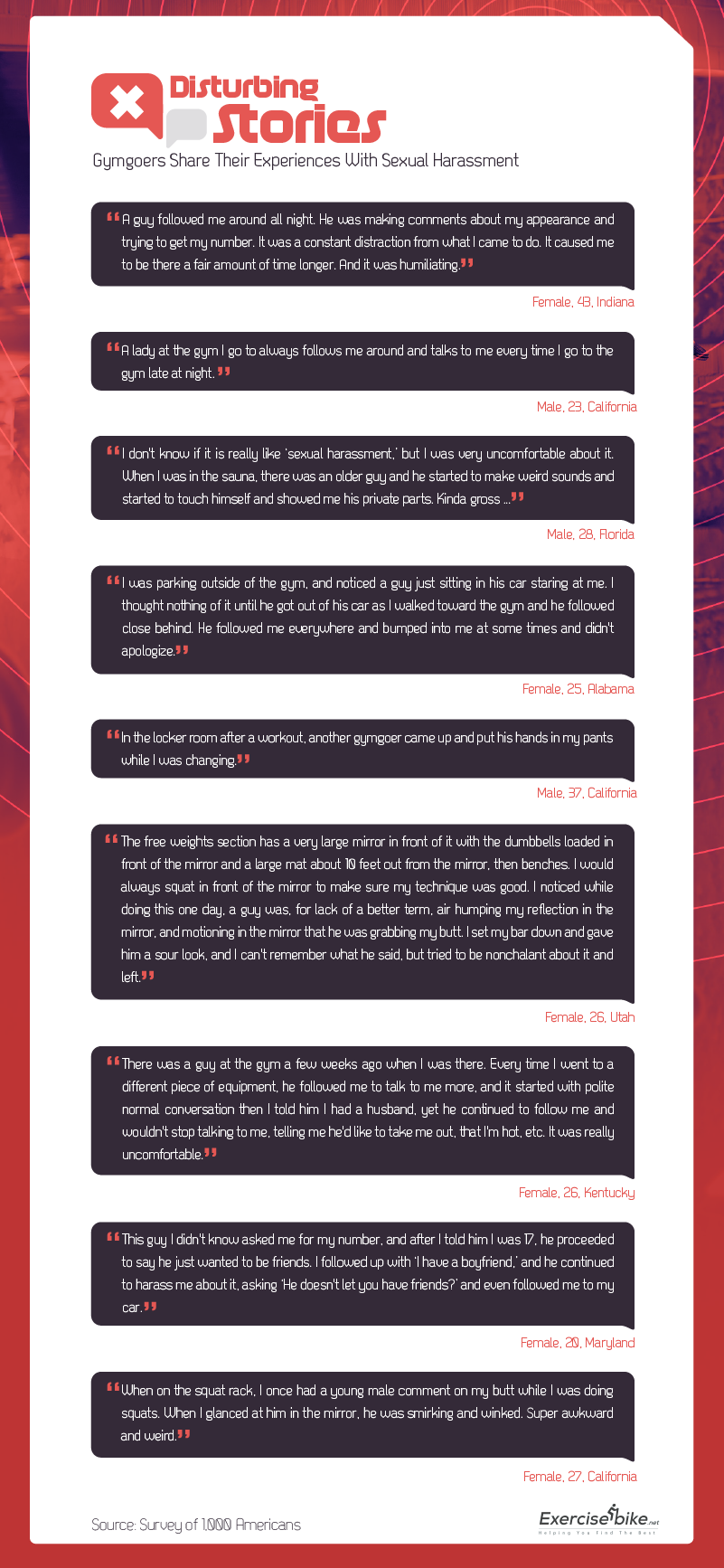
With so many opinions about what qualifies as sexual harassment, and gymgoers admitting to engaging in behaviors others may consider inappropriate, it can be difficult to understand just how uncomfortable these actions make people feel.
To get a clearer understanding, we asked men and women to share their experiences with sexual harassment at the gym and how it made them feel. Like one man who wasn’t sure if another person exposing himself in the sauna was considered sexual harassment or another who said a person put their hands in his pants in the locker room, some of their experiences are chilling. As you explore in our graphic above, these stories epitomize the dangers and discomfort of sexual harassment at the gym.
A Better Way
In this project, men and women shared their experiences with sexual harassment that occurred while stretching, working out, or in the changing room or sauna at their gym. And while most imagined confronting their harassers in one way or another, many told us they didn’t.
No one should ever have to feel uncomfortable while working on his or her well-being or fitness. Instead of letting sexual harassment affect you and your workout routine, bring the gym home with you instead.
Methodology
We surveyed 1,000 Americans on their experiences and perceptions of sexual harassment at the gym to understand how and why sexual harassment is happening and who is perpetrating and experiencing it. Respondents were 50% female and 50% male. Participants ranged in age from 18 to 73, with a mean of 33.6 and a standard deviation of 9.7.
Limitations
The data we are presenting rely on self-reporting. There are many issues with self-reported data. These issues include but are not limited to: selective memory, telescoping, attribution, and exaggeration. No statistical testing was performed, so the claims listed above are based on means alone.
Fair Use Statement
Want to help spread awareness about sexual harassment at the gym? Feel free to share the findings of our study with your readers for any noncommercial use. Just ensure a link back to this page so that they can see our research in its entirety.

